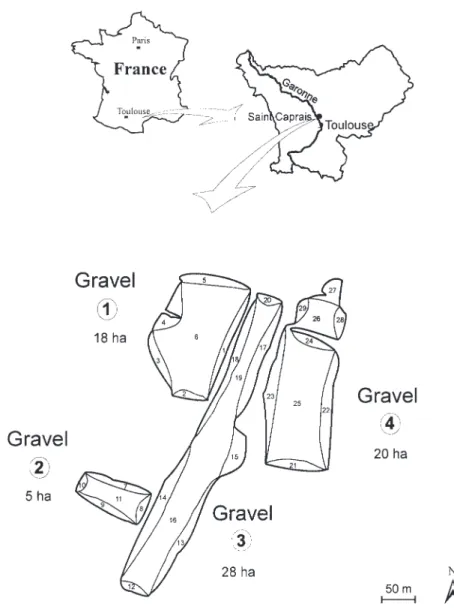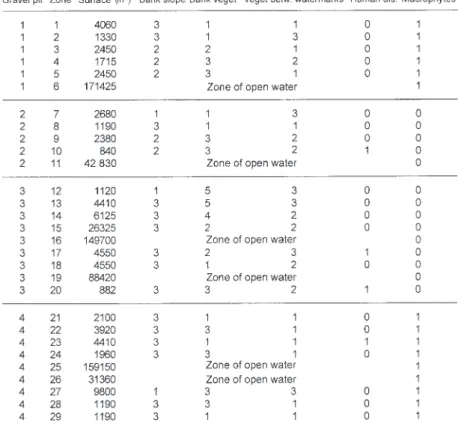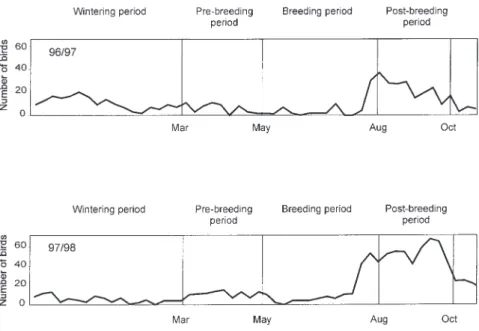HAL Id: hal-03217988
https://hal.sorbonne-universite.fr/hal-03217988
Submitted on 5 May 2021
HAL is a multi-disciplinary open access
archive for the deposit and dissemination of
sci-entific research documents, whether they are
pub-lished or not. The documents may come from
teaching and research institutions in France or
abroad, or from public or private research centers.
L’archive ouverte pluridisciplinaire HAL, est
destinée au dépôt et à la diffusion de documents
scientifiques de niveau recherche, publiés ou non,
émanant des établissements d’enseignement et de
recherche français ou étrangers, des laboratoires
publics ou privés.
GRAVEL PITS AS NEW WETLANDS FOR THE
LITTLE GREBE TACHYBAPTUS RUFICOLLIS
F Santoul, S Mastrorillo
To cite this version:
F Santoul, S Mastrorillo. GRAVEL PITS AS NEW WETLANDS FOR THE LITTLE GREBE
TACHYBAPTUS RUFICOLLIS. Vie et Milieu / Life & Environment, Observatoire Océanologique
-Laboratoire Arago, 2004, pp.31-36. �hal-03217988�
GRAVEL PITS AS NEW WETLANDS
FOR THE LITTLE GREBE TACHYBAPTUS RUFICOLLIS
F. SANTOUL, S. MASTRORILLO
LEH, Laboratoire d’Écologie des Hydrosystèmes, FRE 2630 CNRS/UPS, Université Paul Sabatier, 118 Route de Narbonne, 31062 Toulouse Cedex 04, France santoul@cict.fr FACTEURS ENVIRONNEMENTAUX GRAVIÈRES GRÈBE CASTAGNEUX MACROPHYTES SUD-OUEST DE LA FRANCE
RÉSUMÉ. – Dans le Sud-Ouest de la France, l’augmentation des gravières a permis l’installation de nombreuses espèces d’Oiseaux d’eau. Ces milieux humides sont devenus pour ces dernières des zones de substitution aux milieux naturels. Le Grèbe castagneux Tachybaptus ruficollis a colonisé le Sud-Ouest de la France dans les années 70 à la suite de l’augmentation des exploitations de gravières. Les popu-lations de Grèbe ont été recensées de manière hebdomadaire entre octobre 1996 et octobre 1998 dans quatre gravières situées près de Toulouse. Pour chaque période (hivernage, migrations pré et post-nuptiale, reproduction), nous avons étudié à l’aide de différentes variables environnementales, les habitats fréquentés par les Grèbes. La présence de macrophytes est le facteur le plus important dans le station-nement des Grèbes. Les zones de pleine eau constituent des lieux sécurisants pour cette espèce tout au long de l’année. Ces résultats soulignent la nécessité, dans les plans de conservation des Oiseaux d’eau au niveau des gravières non aménagées, de prendre en considération la gestion des macrophytes.
ENVIRONMENTAL FACTORS GRAVEL PITS LITTLE GREBE MACROPHYTES SOUTHWEST FRANCE
ABSTRACT. – In southwest France, the increasing abundance of gravel pits has al-lowed several bird species to colonize the region. These wetlands have become substitutes for the natural habitats of waterbirds. Little grebes Tachybaptus ruficol-lis have colonized southwest France since the availability of gravel pits expanded and began to be exploited by the species in the 1970’s. Little grebe populations were censused weekly from October 1996 to October 1998 in four gravel pits near Toulouse (SW France). For each period (wintering, post and pre breeding, bree-ding), we recorded the habitat used by grebes according to environmental variables. Of these, the presence of macrophytes proved to be the most important factor in-fluencing the little grebe repartition to gravel pits where open water provides secure habitats for this species year-round. This information will be useful for acquisition and management purposes. Hereafter, in southwest France, conservation efforts for waterbird communities must consider macrophyte management in unused gravel pits as a viable tool to maintain this species.
INTRODUCTION
Human activities result in the destruction of nat-ural wetlands, but also the creation of artificial wetlands such as rice fields, gravel pits, dam lakes, etc. These “new” wetlands have progressively be-come habitats of substitution for wildlife (Senra et al. 1992, Blanco 1996, Blanco & Marchamalo 1999, Parejo & Sanchez-Guzman 1999). During the last century, the extraction of gravel in Euro-pean river floodplains created “new” wetlands: the gravel pits. In England, the value of these aquatic ecosystems for waterbirds is well known. Since 1931, gravel pits are important breeding sites for the great crested grebe Podiceps cristatus (Tydeman 1982). In 1948, counts made in four groups of gravel pits in the London region showed
important species richness of birds, the total num-ber of species listed being 112 (Keywood & Melluish 1953). The importance of gravel pits for breeding success has been noted by several authors (Glue 1970, Hill 1982, Andrews 1990). Gravel pits shelter about 50% of Great Britain’s breeding birds (Hugues et al. 1979, Tydeman 1982). For example, in 1984, 400 breeding pairs of the little ringed plo-ver Charadrius dubius were noted in England, with more than half present on gravel pits (Andrews 1990). In Slovakia, 33% of birds censused were present on gravel pits (Kalivodova & Feriancova-Masarova 1998). In France, gravel pits cover an area of about 90 000 ha, the annual extension of these ecosystems is estimated at 5000 ha (Barnaud & Le Bloch 1998). The creation of these gravel pits has modified the ecosystem, particularly because of the effects on the surrounding hydrosystem
(Frochot et al. 1987). However, the new aquatic environments created permit extensive waterbird colonization which is of great ecological interest (Frochot & Godreau 1995). The creation and the development of gravel pits have permitted popula-tion expansion of numerous species, of which the little grebe Tachybaptus ruficollis is one of the most significant.
We studied the little grebe population in the Saint Caprais gravel pits from October 1996 to October 1998. Simultaneously, we recorded the en-vironmental factors at each site (i.e. vegetation, hu-man disturbance, and bank slope) in order to deter-mine the ecological parameters governing little grebe distribution on gravel pits. This study was undertaken to investigate some aspects of gravel pit characteristics which influence the carrying ca-pacity of the little grebe in southwest France.
MATERIAL AND METHODS
Study sites: In the Midi-Pyrénées region, most of the gravel pits are located near Toulouse in the central part of the Garonne floodplain. The four gravel pits of Saint Caprais where our study occurred are located about 25 km North of Toulouse (Fig. 1). These gravel pits are unmanaged and abandoned. Total water surface area is about 70 ha with a mean depth of 3 m (range 2-4 m). The Oceanic influence predominates over the whole basin, but lessens to the southeast where it comes under the Mediterranean influence with its dry winds and lower rainfall. The annual average air temperature is 12.7oC
with 67.2 cm of precipitation annually.
Little Grebe populations: Weekly censuses were car-ried out from October 1996 to October 1998 using bino-culars (8×30) and a telescope (20×60). The small surface area and open character of the gravel pits permitted a
32 F. SANTOUL, S. MASTRORILLO
full census of the population (Tamisier 1972). The num-ber of grebes observed was recorded for each gravel pit and their position was noted on a map (Fig. 1).
Environmental parameters: To determine the habitat used by grebes, several environmental parameters were recorded (Table I): Macrophytes: present (1), absent (0); bank slope: <30o(1), 30-60o(2), >60o (3); bank
vegeta-tion: absent (1), lawn (2), herbs (3), shrubs (4), trees (5); human disturbance: presence (1) or absence (0) of paths; vegetation between the low-water and high-water mark: absent (1), low (2), high (3). The small amount of vege-tation present only permitted to establish classes of den-sity (Bournaud et al. 1982, Roche 1982). Edge areas and open water areas were also noted (Borowiec 1975).
It is extremely difficult to quantify “human distur-bance” with gravel pits, the presence or the absence of paths is the most important factor in such disturbance. However, periodic disturbances are sometimes very harmful to waterbirds. For this reason “human distur-bance” must be considered as a general estimation of all disturbances. Changes between years (1996/97, 1997/98) were analyzed.
In order to study the temporal distribution of grebes, we selected four annual periods in accordance with Joa-chim et al. (1997): wintering period from October to February; pre-breeding period from March to April; post-breeding period from August to September and breeding period from May to July. During each period, statistical analyses were performed to highlight the in-fluence of environmental factors.
Variation in grebe density relative to environmental parameters was estimated by analysis of variance
(ANOVA) with one criterion of classification (Wilkinson 1989). When the variations were significant (P<0.05; P<0.01; P<0.001), the analysis was supplemented by a Tukey test. Statistical analysis was carried out using Systat software –9.0.
RESULTS
Grebe population
At the beginning of August grebe numbers at Saint Caprais increased from about 10 to more than 40 little grebes. The number of birds reached its maximum during the post-breeding period, where a peak of 60 birds was noted in 1998 (Fig. 2). During the other phenological periods, the average grebe numbers for each census is about 10 birds. Grebe populations observed during each period were sim-ilar for both years of the study.
Environmental parameters
Considering the low number of grebes during the wintering, pre-breeding and breeding periods, the statistical analyses were performed only during the post breeding period. Grebes preferred areas of
open water (p<0.001) and areas with macrophytes (p<0.001). Concerning macrophytes, Nitella sp (Characea) is the most abundant species even if few patches of Myriophyllum spicatum and Ranunculus trichophyllus could be noted. During the post-breeding period the presence of grebes was also correlated with a bank slope between 30-60o (p<0.01). The other factors (bank
vegeta-tion, vegetation between watermarks and human disturbance) did not influence little grebe distribu-tion on Saint Caprais gravel pits. There were no significant differences between the two years stud-ied.
DISCUSSION
At Saint Caprais, grebe numbers reached their maximum during the post-breeding period, more than 60 birds were noted during one count. The large number of grebes censused during this period represents moult assemblies. Little is published on moult migration of the little grebe, although it is known that they tend to assemble in good moulting sites right after the breeding is over. At the re-gional level, a peak of migrating grebes was also noted in August, September and October, where between 50 and 100 birds were observed on large regional wetlands (Bousquet 1997). For these rea-sons, the gravel pits of Saint Caprais have become one of the principal sites for the little grebe during the moulting period in the Midi-Pyrénées region with more than 40% of the little grebe populations located on gravel pits there (Joachim & Bousquet 1996).
The presence of grebes was correlated with macrophytes, and particularly with Characea (anat-omy similar to macrophytes). These Characea were present in all the water column. They shelter nu-merous molluscs and aquatic invertebrates that constitute an important trophic resource for the lit-tle grebe (Santoul 2000). During the breeding pe-riod, grebes essentially feed only on aquatic inver-tebrates. In winter, when aquatic invertebrates are less numerous, grebes forage on various species of fish (Andrews 1991). However, wetlands with huge fish populations do not suit them particularly, in this case competition between fish and birds on in-vertebrates may occur (Santoul & Mastrorillo 2003). During the post-breeding period, grebes were associated with bank slopes between 30-60o.
Protection against wind seemed to be the main rea-son for this behaviour (Olney 1964, Santoul 2000).
At Saint Caprais, grebes preferred open water areas where they could pursue their activities (feeding, preening) in safety. Cramp & Simmons (1984) have noted that the zone preferred by the lit-tle grebe was in open water areas, except during the breeding period. In the gravel pits studied grebes were located on open water areas, during all periods of the year. This difference may be ex-plained by either of the following hypotheses: in Saint Caprais, 1) grebes located on reed bed zones were not visible and thus undercensused; or, 2) some grebes don’t take part in breeding activities and were therefore present preferentially on open water areas. At Saint Caprais gravel pits, breeding signs were noted for few birds (one or two pairs), however no nests or broods were observed. In these gravel pits, the relatively small surface area of reed beds was inadequate to allow the breeding of nu-merous territorial pairs. For breeding success of
34 F. SANTOUL, S. MASTRORILLO
this species, abundance of aquatic vegetation (trophic resources) and riparian vegetation (hiding of broods and nests) were felt to be predominant considerations (Andrews 1991). Prior to 1980, the little grebe was not widespread in the Midi-Pyrénées, however, in the last twenty years a spec-tacular increase in colonization by this species was noticed. This phenomenon can be explained by the creation of artificial wetlands such as gravel pits (Joachim et al. 1997). These ecosystems are very important for the protection and reproduction of many species, but the lack of management (steep slopes, absence of islands) still limits their ecologi-cal development, and hence impact on carrying ca-pacity of this species. Restoration is generally car-ried out to transform gravel pits into recreational areas or fishing lakes, and only rarely into habitats favourable to waterbirds. Because of the increasing number of new wetlands (reservoirs, rice planta-tions, gravel pits) compared to the small remaining area of “natural” zones, we must do more to recog-nize and enhance their potential contribution to fu-ture conservation of waterbird species and commu-nities.
ACKNOWLEDGEMENTS. – We thank the society ‘les
Sa-blières de Garonne’ to permit us to realise this work in the best conditions as possible. We appreciate the impro-vements in English usage made by P Whitford.
REFERENCES
Andrews J 1990. Principles of restoration of gravel pits for wildlife. British Wildlife 2: 80-88.
Andrews J 1991. Restoration of Gravel Pits for Wildlife. RSPB Conserv Rev 5: 12.
Barnaud G, Le Bloch F 1998. Entre Terre et Eau, Agir pour les zones humides, Dossier d’information. Mi-nistère de l’aménagement du territoire et de l’envi-ronnement.
Blanco G 1996. Population dynamics and communal ro-osting of White Storks foraging at a Spanish refuse dump. Colonial Waterbirds 19 (2): 273-276. Blanco G, Marchamalo J 1999. Post-breeding Inland
Movements and Use of Refuse Dumps by Audouin’s Gulls in Spain. Water-birds 22 (2): 307-309. Borowiec E 1975. Food of coot (Fulica atra L.) in
diffe-rent phenological periods. Polsk Archiv Hydrobiol 22 (2): 157-166.
Bournaud M, Ledant JP, Broyer J, Richoux M 1982. L’espace étang dans ses rapports avec l’avifaune en période de nidification. Bull Ecologie 13 (2): 125-144.
Bousquet JF 1997. Le Canard colvert. In Joachim J, Bousquet JF, Faure C. Atlas des Oiseaux nicheurs de Midi-Pyrénées, Association Régionale Ornitholo-gique de Midi-Pyrénées, 262 p.
Cramp S, Simmons KEL 1984. Birds of the western Pa-leartic, Vol. 1. Oxford University Press, Oxford. Frochot B, Pages J, Lanet B, Gambade G 1987. Impact
écologique des extractions de granulats dans le lit du Doubs en Saône-et-Loire. Equipe Ecologie Univ Bourgogne, 52p.
Glue DE 1970. Changes in the bird community of a Hampshire gravel pit 1963-1968. Bird Study 17: 15-27.
Hill DA 1982. Habitat requirements of breeding water-fowl on gravel quarries: management implications. The Proceed Symp wildlife on man-made wetlands: 43-69.
Hughes SWM, Bacon P, Flegg JJM 1979. The 1975 cen-sus of the Great Crested Grebe in Britain. Bird Study 26 (4): 213-226.
Joachim J, Bousquet JF 1996. Inventaire écologique des gravières du Vernet (31), expertise écologique. In étude pour le Cabinet Ectare, Saint Jean.
Joachim J, Bousquet JF, Faure C 1997. Atlas des oiseaux nicheurs de Midi-Pyrénées, Association Régionale Ornithologique de Midi-Pyrénées, 262p.
Kalivodova E, Feriancova-Masarova Z 1998. Bird com-munities of the gravel pits of Western Slovakia. Eko-logia 17 (4): 407-418.
Keywood KP, Melluish WD 1953. A report on the bird populations of four gravel pits in the London area, 1948-1951. London Bird Report 17: 43-72.
Olney PJS 1964. Gravel pits as waterfowl reserves. IUCN Publi New Ser 3: 414-420.
Parejo D, Sanchez-Guzman JM 1999. Effects of Agricul-tural Development on Colonial Ardeid Populations in Southwestern Spain. Waterbirds 22 (2): 302-306. Roche J 1982. Structure de l’avifaune des étangs de la
plaine de Saône: influence de la superficie et de la di-versité végétale. Alauda 3: 193-215.
Santoul F 2000. L’avifaune aquatique des gravières de la plaine alluviale de la Garonne. Thèse, Univ Toulouse III, 207 p.
Santoul F, Mastrorillo S 2003. Interaction between fish and waterbird communities: a case study of two gra-vel pits in South-West France. Vie Milieu 53 (2/3): 131-134
Senra A, Ales EE 1992. The decline of the white stork Ciconia ciconia population of western Andalusia bet-ween 1976 and 1988: causes and proposal for conser-vation. Biol Conserv 61: 51-57.
Tamisier A 1972. Etho-écologie des sarcelles d’hiver (Anas c. crecca L.) pendant leur hivernage en ca-margue. Thèse Univ Montpellier, 157 p.
Tydeman C 1982. The general value of man-made we-tlands for wildlife in Europe. The Proceed Sympos Wildlife on man-made wetlands: 5-18.
Wilkinson L 1989. Systat: the system for statistics. Evanston, Illinois: systat INC, 638 p.
Reçu le 3 juin 2003; received June 3, 2003 Accepté le 10 novembre 2003; accepted November 10, 2003



